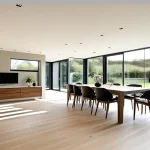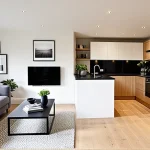Practical Layout Strategies for Small UK Homes
Maximising floor space in small UK homes demands thoughtful arrangements that improve flow and openness. In many UK terraces and flats, limited square footage can feel cramped without careful planning. One effective strategy is placing furniture along walls to free central areas, creating clearer pathways that enhance movement.
Creating multifunctional zones is essential in small space layouts. For example, combining a dining area with a workspace saves space while maintaining functionality. Using compact pieces like fold-away tables or stackable chairs supports flexible use without overcrowding.
Additional reading : How Can Modern Technology Transform Your UK Home Living?
For real-life UK home layouts, it’s crucial to assess natural light sources and arrange seating to face windows where possible. This not only opens the room visually but also creates a welcoming environment. In narrow terraces, longitudinal layout—aligning furniture lengthwise—can help reduce congestion and make rooms feel longer.
By thoughtfully arranging furniture and utilising multifunctional zones, UK residents can dramatically improve the feel and utility of their small spaces while making the most of every square foot available.
Topic to read : What Are the Essential Features of Modern UK Home Design?
Practical Layout Strategies for Small UK Homes
Maximising floor space in small UK homes demands strategic thinking, especially with typical UK home layouts like terraces and flats. Begin by focusing on small space layout principles that encourage natural flow and openness. For instance, positioning furniture away from pathways avoids a cramped feeling and enhances movement throughout compact rooms.
Creating multifunctional zones is key. In limited square footage, use furniture that delineates spaces without physical barriers. A dining table that doubles as a workspace or a sofa that separates living and dining areas exemplifies efficient use of space. In UK terraces, where rooms are often narrow, align seating along walls and opt for compact storage pieces to keep floors clear.
Real-life tips include choosing transparent or lightweight furniture and keeping window areas unobstructed to invite natural light, which visually expands rooms. Also, consider how door swings can impact the usable area—pocket or sliding doors save crucial space in flats where every inch counts. By adopting these layout strategies, homeowners can create a sense of openness and functionality despite space constraints.
Clever Storage Solutions to Reduce Clutter
Smart clever storage is essential for maximising floor space in small UK homes. Integrating multi-purpose storage units and furniture works wonders, saving both space and effort. For instance, ottomans with hidden compartments or beds with built-in drawers provide seating and storage simultaneously.
Utilising vertical space is a game changer in small home storage. Shelving up to the ceiling, wall-mounted hooks, and over-door racks keep belongings organised without eating into valuable floor area. This approach is particularly effective in narrow UK flats where floor space is at a premium.
When considering small home storage ideas, compact modular units adapt well to irregular room shapes found in terraced houses. There are many space-saving furniture options designed specifically for UK homes, such as stackable chairs or fold-down desks. These practical choices offer flexibility and reduce clutter.
By focusing on clever storage and space-saving furniture, residents in UK terraces and flats can maintain neat, spacious interiors that feel open rather than overcrowded. Such solutions complement other strategies for small space layout by keeping surfaces clear and pathways accessible.
Practical Layout Strategies for Small UK Homes
Maximising floor space in small UK homes begins with deliberate small space layout choices that enhance flow and openness. Arrange furniture to avoid blocking pathways, especially in UK terraces and flats where space is tight. Positioning seating alongside walls opens central areas, creating an illusion of spaciousness and improving movement.
Creating multifunctional zones is vital to balance limited square footage with usability. A desk placed next to a dining table can serve as a workspace without requiring extra room. Similarly, a bookshelf can function as a room divider, defining zones without eating into floor space.
In real-life UK home layouts, consider natural light and traffic patterns. Clear access to windows maximises brightness, which visually expands the area. Also, keeping door swings and circulation routes unimpeded preserves usable floor space. Prioritising flexible furniture arrangements allows residents to adapt rooms throughout the day, supporting diverse activities without feeling cramped.
By focusing on furniture placement, multifunctional zones, and flow, these strategies effectively address the challenges of maximising floor space in small UK homes.
Practical Layout Strategies for Small UK Homes
Efficient small space layout hinges on thoughtful furniture placement that enhances flow and openness. In typical UK home layouts like terraces and flats, position key pieces such as sofas and tables along walls to keep central areas clear. This arrangement not only maximises floor space but also allows for easier movement and reduces the cramped feel common in compact rooms.
Creating multifunctional zones is vital when square footage is limited. Consider combining dining and workspace areas or using a sofa as a room divider to define separate zones without walls. This strategy fits well in narrow UK terraces, where a longitudinal layout helps extend the perceived length of rooms.
Practical tips for maximising floor space include using lightweight or transparent furniture, which visually declutters the area. Additionally, avoid blocking windows to maintain natural light, and be mindful of door swings—opting for sliding or pocket doors when possible preserves valuable usable space. These layered tactics support a layout that feels open, functional, and tailored to the unique challenges of small UK homes.
Practical Layout Strategies for Small UK Homes
Effective small space layout hinges on arranging furniture to enhance movement and openness, crucial in typical UK home layouts like terraces and flats. Avoid clustering pieces in the centre; instead, place sofas, chairs, and tables along walls to keep pathways clear and maintain a sense of flow. This positioning reduces visual clutter and makes rooms feel larger.
Creating multifunctional zones is especially important where maximising floor space is a priority. For example, a fold-away dining table can double as a workspace, while a bookshelf can separate living and dining areas without consuming excessive space. Such zones ensure each area serves more than one purpose, critical in UK homes with compact rooms.
Real-life advice for UK terraces includes aligning seating lengthwise to elongate rooms visually. Ensure pathways between doorways and windows remain unobstructed to improve traffic flow and natural light penetration. Consider door swings carefully; replacing standard doors with sliding or pocket options can free up valuable floor space, aiding better furniture arrangements.
These strategies collectively support practical, adaptable layouts tailored to the realities of UK home layouts while maximising floor space efficiently.
Practical Layout Strategies for Small UK Homes
Arranging furniture thoughtfully is crucial for maximising floor space in compact properties typical of UK home layouts. Place sofas and tables against walls to keep central pathways clear, which improves the room’s flow and openness. This method prevents congestion, especially important in narrow terraces and small flats where space is limited.
Creating multifunctional zones is key in a small space layout. For example, a fold-away table can serve as both a dining surface and a desk, making efficient use of limited square footage. Similarly, using furniture like shelving units to divide areas without walls keeps spaces practical yet unobtrusive, helping rooms feel larger.
Real-life UK homes benefit from aligning seating lengthwise to extend perceived room depth. Additionally, maintaining unobstructed routes between doorways and windows preserves natural traffic flow and light. Considering door replacement with sliding or pocket options can further enhance available space. These strategies not only support daily living but also adapt well to the distinct dimensions and layouts found across UK houses.
Practical Layout Strategies for Small UK Homes
Optimising a small space layout requires careful furniture placement to promote flow and openness within typical UK home layouts such as terraces and flats. Positioning larger items like sofas and dining tables against walls frees up central areas, reducing congestion and making movement easier. This approach improves the room’s functional flow.
Creating multifunctional zones maximises the use of limited square footage. For example, integrating a fold-away desk near the dining area can serve as a workspace without needing extra room. Similarly, shelving units can act as subtle dividers, designating living and dining spaces while preserving openness.
In real-life UK home layouts, arranging seating lengthwise in narrow terraces visually extends the room’s depth. It also helps to maintain unobstructed pathways between doors and windows to encourage natural light and smooth circulation. Evaluating door swings and opting for sliding or pocket doors further enhances usability by saving floor space.
Together, these strategies for maximising floor space balance practicality and comfort, enabling small UK homes to feel more spacious and functional despite their size constraints.







